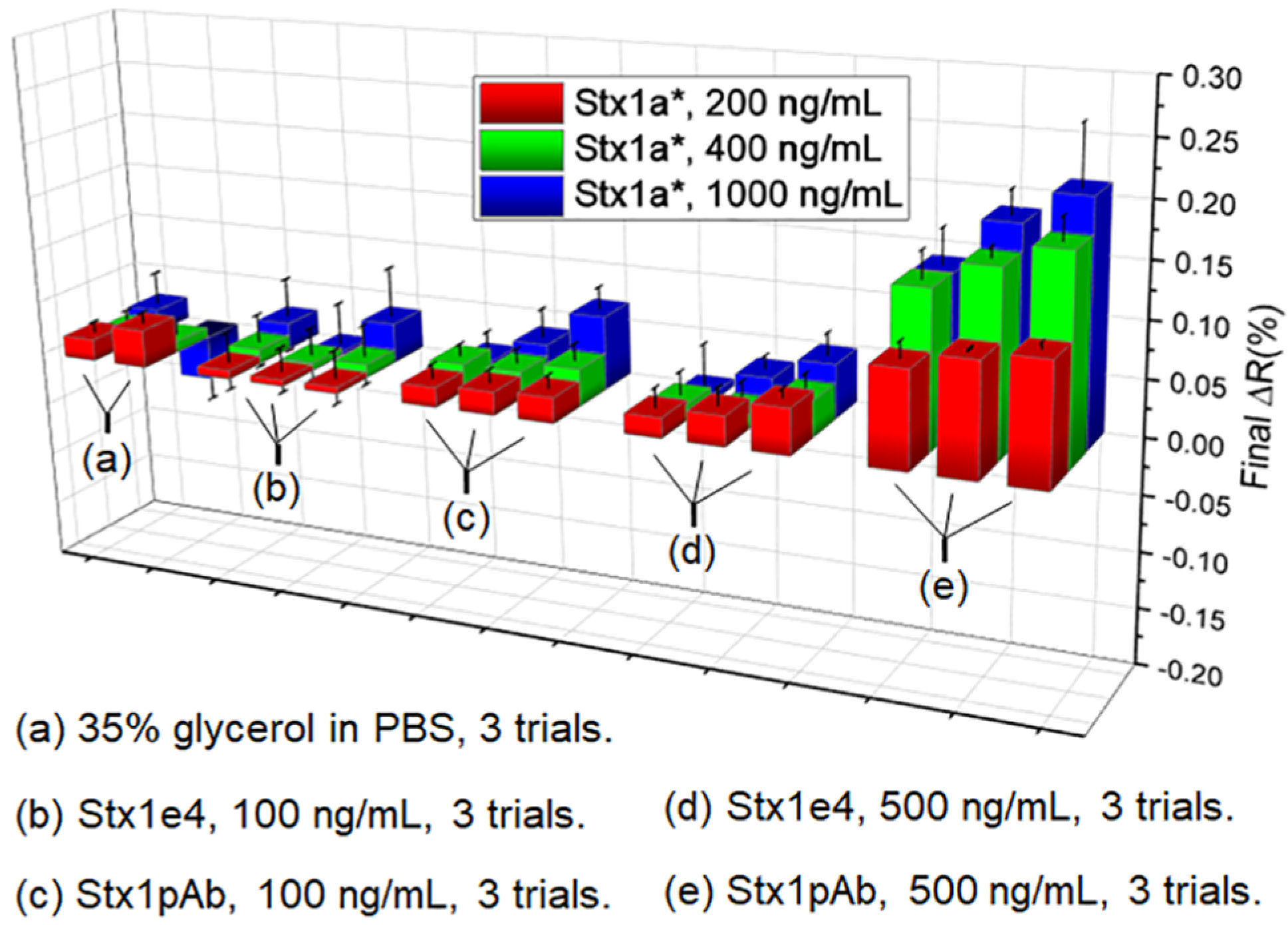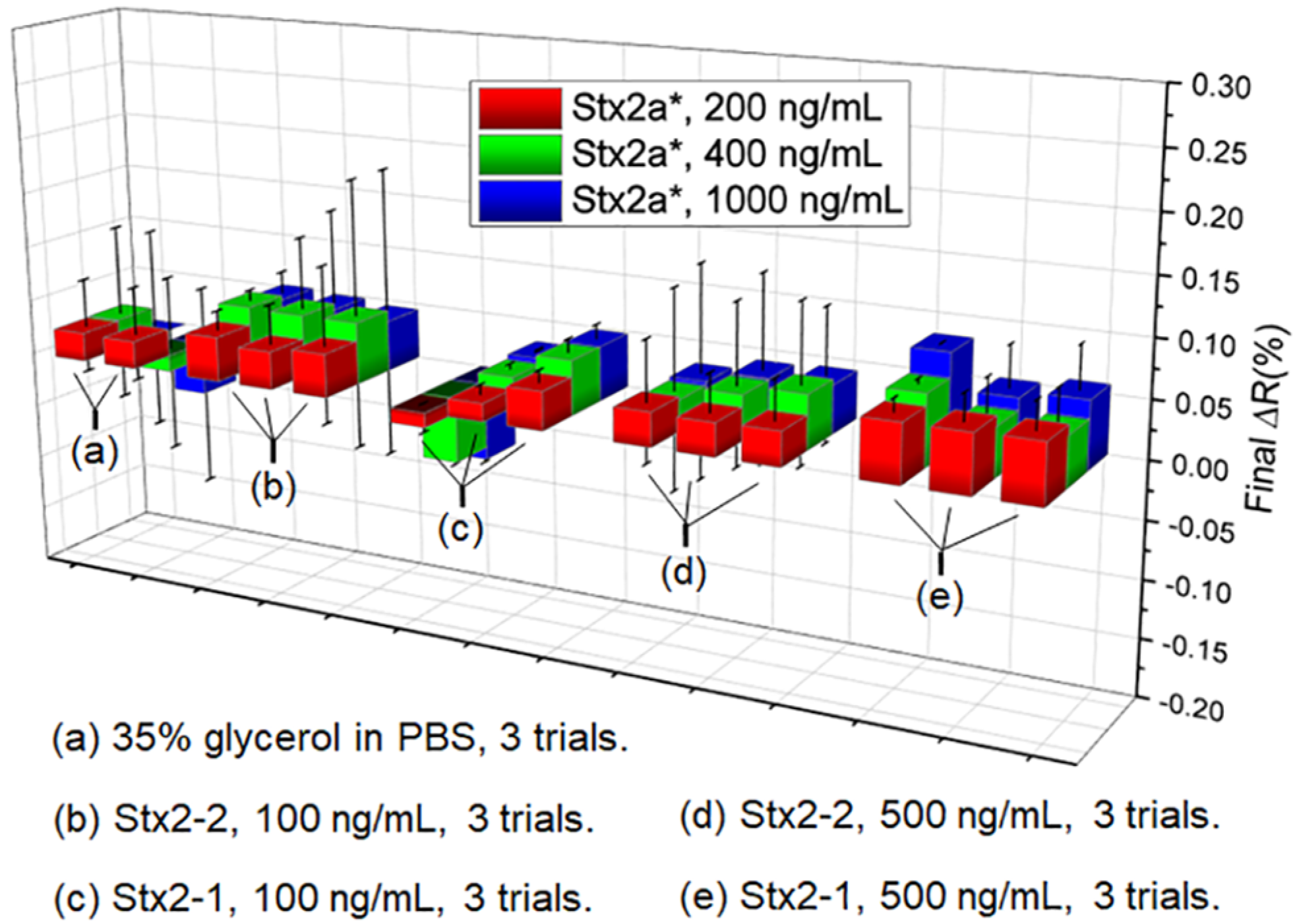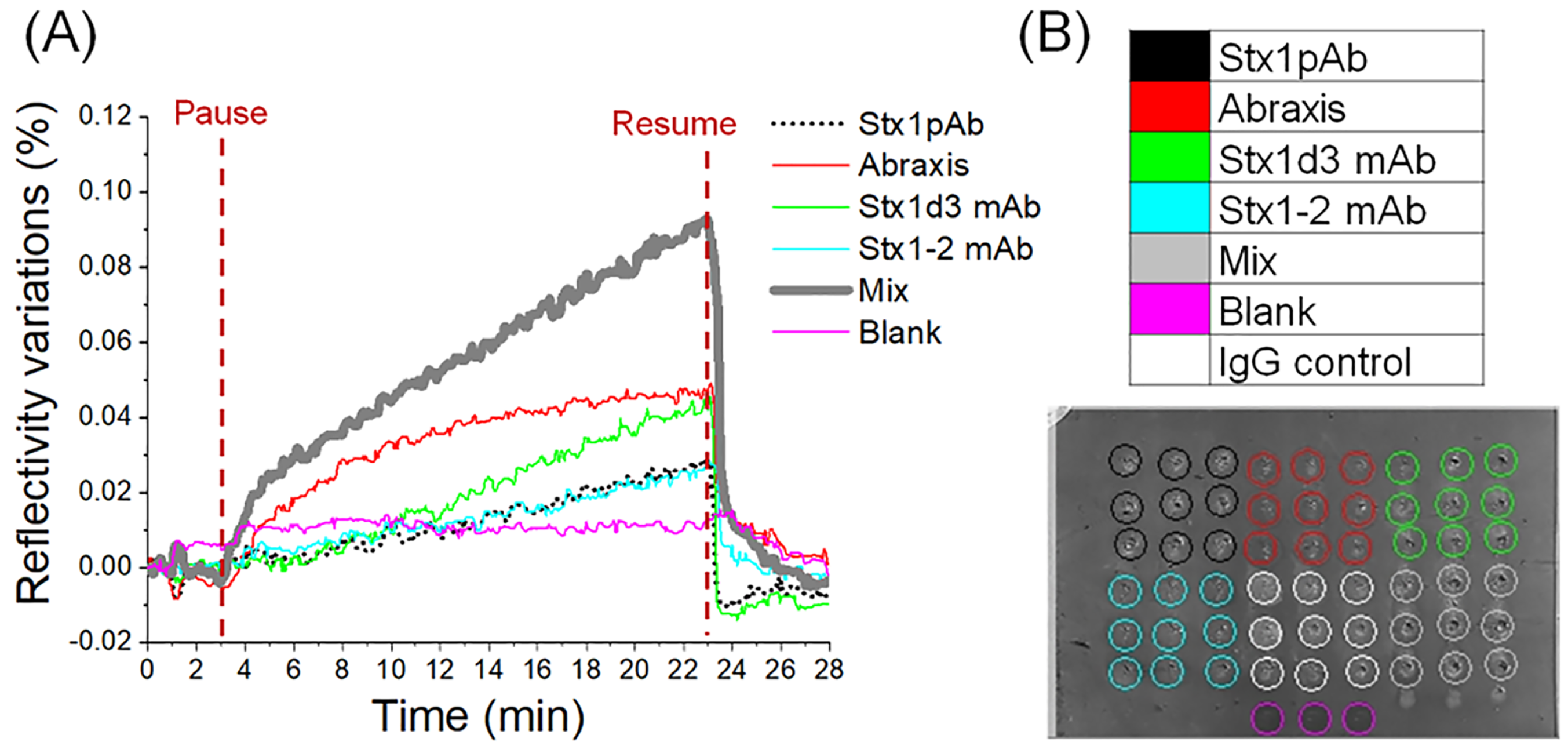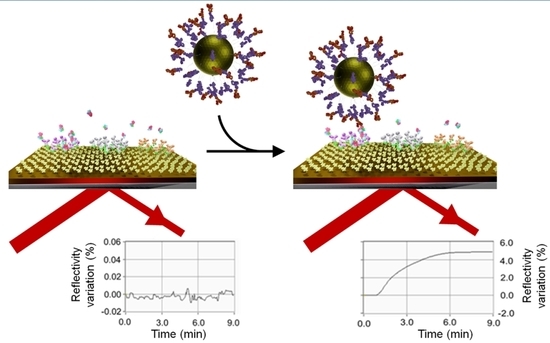Rapid and Label-Free Immunosensing of Shiga Toxin Subtypes with Surface Plasmon Resonance Imaging
Abstract
1. Introduction
2. Results and Discussion
2.1. Detection of Stx with Direct Label-Free Immunoassay
2.2. Signal Amplification with Gold Nanoparticle (GNP)
3. Conclusions
4. Materials and Methods
4.1. Materials
4.2. SPRi Biochip Fabrication
4.3. Synthesis of GNP-Antibody Conjugate
4.4. Surface Plasmon Resonance Imaging
Supplementary Materials
Author Contributions
Funding
Acknowledgments
Conflicts of Interest
References
- Croxen, M.A.; Law, R.J.; Scholz, R.; Kristie, M.K.; Wlodarska, M.; Finlay, B.B. Recent Advances in Understanding Enteric Pathogenic Escherichia Coli. Clin. Microbiol. Rev. 2013, 26, 822–880. [Google Scholar]
- Feng, P.; Weagant, S.D.; Jinneman, K. Bacteriological Aanlytical Manual Chapter 4a Diarrheagenic Escherichia Coli; FDA: Silver Spring, MD, USA, 2019. [Google Scholar]
- Chen, J.; Park, B. Label-Free Screening of Foodborne Salmonella Using Surface Plasmon Resonance Imaging. Anal. Bioanal. Chem. 2018, 410, 5455–5464. [Google Scholar]
- Melton-Celsa, A.R. Shiga Toxin (Stx) Classification, Structure, and Function. Microbiol. Spectr. 2014, 2. [Google Scholar] [CrossRef]
- Jinneman, K.C.; Yoshitomi, K.J.; Weagant, S.D. Multiplex Real-Time PCR Method to Identify Shiga Toxin Genes Stx1 and Stx2 and Escherichia Coli O157:H7/H-Serotype. Appl. Environ. Microb. 2003, 69, 6327–6333. [Google Scholar]
- Skinner, C.; Patfield, S.; Stanker, L.H.; Fratamico, P.; He, X. New High-Affinity Monoclonal Antibodies against Shiga Toxin 1 Facilitate the Detection of Hybrid Stx1/Stx2 in Vivo. PLoS ONE 2014, 9, e99854. [Google Scholar]
- He, X.; McMahon, S.; Skinner, C.; Merrill, P.; Scotcher, M.C.; Stanker, L.H. Development and Characterization of Monoclonal Antibodies against Shiga Toxin 2 and Their Application for Toxin Detection in Milk. J. Immunol. Methods 2013, 389, 18–28. [Google Scholar]
- Fuller, C.A.; Pellino, C.A.; Flagler, M.J.; Strasser, J.E.; Weiss, A.A. Shiga Toxin Subtypes Display Dramatic Differences in Potency. Infect. Immun. 2011, 79, 1329–1337. [Google Scholar]
- He, X.; Kong, Q.; Patfield, S.; Skinner, C.; Rasooly, R. A New Immunoassay for Detecting All Subtypes of Shiga Toxins Produced by Shiga Toxin-Producing E. Coli in Ground Beef. PLoS ONE 2016, 11, e0148092. [Google Scholar]
- Gould, L.H.; Bopp, C.; Strockbine, N.; Atkinson, R.; Baselski, V.; Body, B.; Carey, R.; Crandall, C.; Hurd, S.; Kaplan, R.; et al. Recommendations for Diagnosis of Shiga Toxin--Producing Escherichia Coli Infections by Clinical Laboratories. MMWP Recomm. Rep. 2009, 58, 1–14. [Google Scholar]
- Cornick, N.A.; Jelacic, S.; Ciol, M.A.; Tarr, P.I. Escherichia Coli O157:H7 Infections: Discordance between Filterable Fecal Shiga Toxin and Disease Outcome. J. Infect. Dis. 2002, 186, 57–63. [Google Scholar]
- Castielloa, F.R.; Tabrizian, M. Gold Nanoparticle Amplification Strategies for Multiplex Spri-Based Immunosensing of Human Pancreatic Islet Hormones. Analyst 2019, 144, 2541. [Google Scholar]
- Hossain, M.Z.; Maragos, C.M. Gold Nanoparticle-Enhanced Multiplexed Imaging Surface Plasmon Resonance (iSPR) Detection of Fusarium Mycotoxins in Wheat. Biosens. Bioelectron. 2018, 101, 245–252. [Google Scholar]
- Špringer, T.; Song, X.C.; Ermini, M.L.; Lamačová, J.; Homola, J. Functional Gold Nanoparticles for Optical Affinity Biosensing. Anal. Bioanal. Chem. 2017, 409, 4087–4097. [Google Scholar]
- Cao, Y.; Griffith, B.; Bhomkar, P.; Wishartb, D.S.; McDermott, M.T. Functionalized Gold Nanoparticle-Enhanced Competitive Assay for Sensitive Small-Molecule Metabolite Detection Using Surface Plasmon Resonance. Analyst 2018, 143, 289. [Google Scholar]
- Yang, Y.S.; Moynihan, K.D.; Bekdemir, A.; Dichwalkar, T.M.; Noh, M.M.; Watson, N.; Melo, M.; Ingram, J.; Suh, H.; Ploegh, H.; et al. Targeting Small Molecule Drugs to T Cells with Antibody-Directed Cell-Penetrating Gold Nanoparticles. Biomater. Sci. 2019, 7, 113–124. [Google Scholar]
- Yang, T.; Zhao, B.; Kinchla, A.J.; Clark, J.M.; He, L. Investigation of Pesticide Penetration and Persistence on Harvested and Live Basil Leaves Using Surface-Enhanced Raman Scattering Mapping. J. Agric. Food Chem. 2017, 65, 3541–3550. [Google Scholar]
- He, X.; Ardissino, G.; Patfield, S.; Cheng, L.W.; Silva, C.J.; Brigotti, M. An Improved Method for the Sensitive Detection of Shiga Toxin 2 in Human Serum. Toxins 2018, 10, 59. [Google Scholar]
- Wang, B.; Lou, Z.; Park, B.; Kwon, Y.; Zhang, H.; Xu, B. Surface Conformations of an Anti-Ricin Aptamer and Its Affinity for Ricin Determined by Atomic Force Microscopy and Surface Plasmon Resonance. Phys. Chem. Chem. Phys. 2015, 17, 307–314. [Google Scholar]
- Soler, M.; Belushkin, A.; Cavallini, A.; Kebbi-Beghdadi, C.; Greub, G.; Altug, H. Multiplexed Nanoplasmonic Biosensor for One-Step Simultaneous Detection of Chlamydia Trachomatis and Neisseria Gonorrhoeae in Urine. Biosens. Bioelectron. 2017, 94, 560–567. [Google Scholar]






© 2020 by the authors. Licensee MDPI, Basel, Switzerland. This article is an open access article distributed under the terms and conditions of the Creative Commons Attribution (CC BY) license (http://creativecommons.org/licenses/by/4.0/).
Share and Cite
Wang, B.; Park, B.; Chen, J.; He, X. Rapid and Label-Free Immunosensing of Shiga Toxin Subtypes with Surface Plasmon Resonance Imaging. Toxins 2020, 12, 280. https://doi.org/10.3390/toxins12050280
Wang B, Park B, Chen J, He X. Rapid and Label-Free Immunosensing of Shiga Toxin Subtypes with Surface Plasmon Resonance Imaging. Toxins. 2020; 12(5):280. https://doi.org/10.3390/toxins12050280
Chicago/Turabian StyleWang, Bin, Bosoon Park, Jing Chen, and Xiaohua He. 2020. "Rapid and Label-Free Immunosensing of Shiga Toxin Subtypes with Surface Plasmon Resonance Imaging" Toxins 12, no. 5: 280. https://doi.org/10.3390/toxins12050280
APA StyleWang, B., Park, B., Chen, J., & He, X. (2020). Rapid and Label-Free Immunosensing of Shiga Toxin Subtypes with Surface Plasmon Resonance Imaging. Toxins, 12(5), 280. https://doi.org/10.3390/toxins12050280






